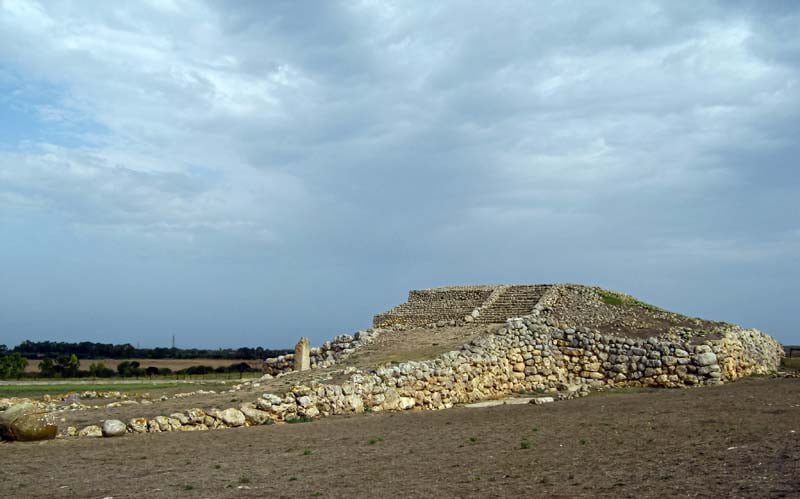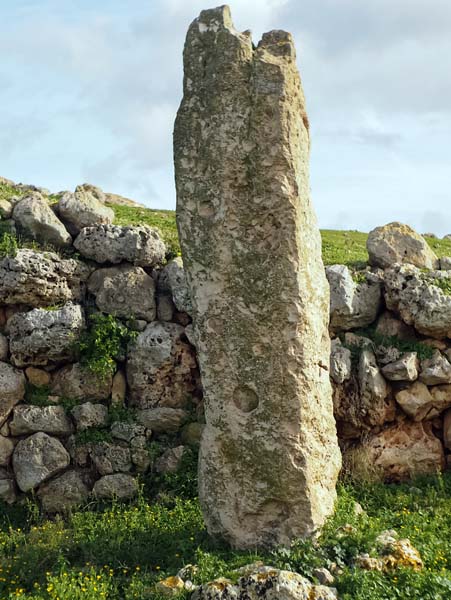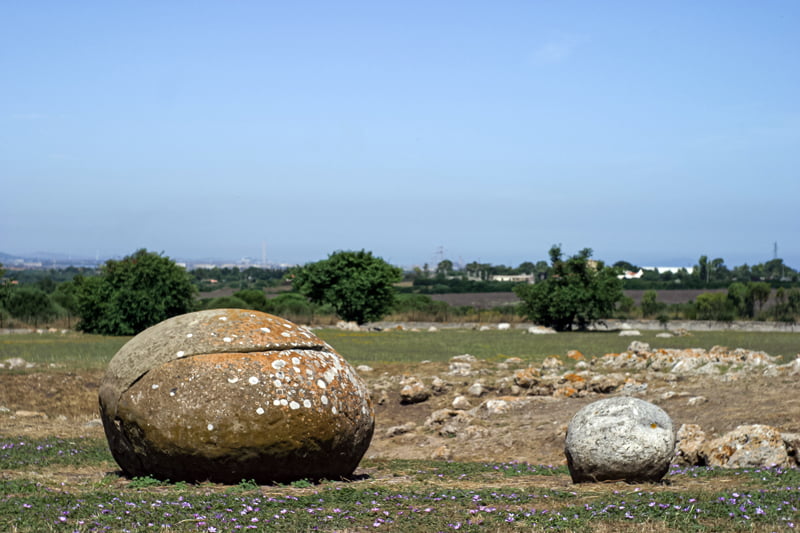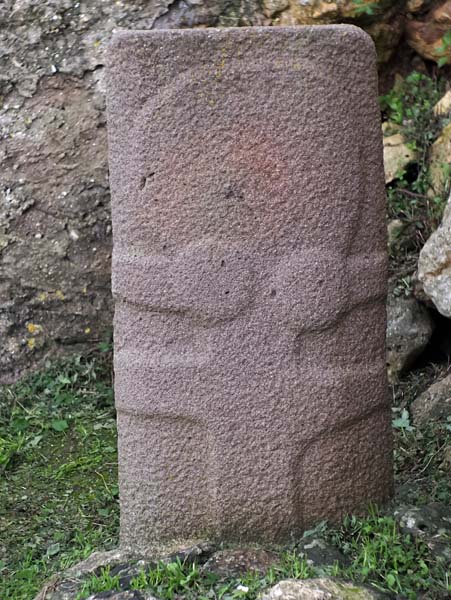di Roberto Marras
During the now distant academic year 1989/90 I had the pleasure of following the lessons of prof. Santo Tinè, then professor of palethnology at the University of Genoa.
To his credit he already boasted considerable excavation experience in his native Sicily, under the guidance of Luigi Bernabò Brea, and in various other regions of Italy, including those of Scalaria cave of Manfredonia, in Puglia, in collaboration with Marija Gimbutas, the extraordinary scholar of Lithuanian origin to whom this site rightly pays homage. Furthermore, she had participated in excavations in Fezzan, in Libya, and in Greece, on behalf of the Italian Archaeological School of Athens, especially in Poliochni, on the island of Lemnos.
Surely, however, the excavations that most of all had characterized the work of the important Sicilian prehistoricist had been those of Monte d'Accoddi, about 8 km southeast of Porto Torres, along the road to Sassari, in northern Sardinia, to which Tinè devoted himself for over 10 years between 1979 and the very year in which I was his student.
I dusted off - it is appropriate to say - the very concise notes that I had taken during his lessons on Monte d'Accoddi:
Monte d'Accoddi was considered the first and only example of a ziggurat in the central Mediterranean; the bases of huts were considered those of a cultic village. But Monte d'Accoddi has only been seriously excavated in recent years and it has been possible to understand that the village was previous and that the same spectacular monument is superimposed on another previous one.
At first it was wondered if it was a tomb but, after the excavations made, it has not yet been found.
It is a quadrangular structure of 28 x 36 m, on one side of which a 45 m ramp opens [1] which overlaps the ramp of the previous monument, which among other things was also directed more to the right of the monument than the more recent one.
The overlap is explained by a takeover by different subjects compared to the previous builders.
The height of the outer wall was at least 5,40 m according to the estimate made on the remaining block and on the collapsed blocks around the wall.
On the central platform a round mound still rises 3 m.
By initially sectioning the 3 m mound, only inconsistent material was found and exploration was interrupted due to the danger of collapse. At the time, Tinè thought that the monument could cover either an artificial cave tomb or a dolmen, but it has not been possible to prove it.
Subsequently a new section was undertaken reinforcing the walls to avoid collapse and the level of 5,40 m was reached, revealing a wall built with mortar and sectioned stones and then plastered. An attempt was made to disassemble the wall and it was possible to reach the rock, always propping up the walls. Under the wall ceramic and other material dating back to the culture of San Michele di Ozieri was found. A ravine with Neolithic material was found under the rock and it was not possible to verify whether it was a natural cavity, as is probable, or an artificial one. In any case, the Neolithic material was not patched up, but stratified in an orderly manner and it was possible to recognize that it belonged to a little known phase of the Sardinian Neolithic, but attested in the Green Grotto near Alghero, the underwater one, and in the Corsican cave of Currachjaghju, perhaps in its own right between the cultures of Bonu Ighinu and that of Ozieri, whereas at first it was considered an initial phase of the latter.
After the central section, others were made, useful for highlighting the fact that it was indeed a quadrangular structure.
Under the menhir there is carbonaceous soil which contained animal bones: it was a combustion pit produced by flaming stones for cooking meat and focaccia, while no shells of cardio (clams), however very present in the finds attributed to the culture that had built the sanctuary, to the point that it can be said that it was one of the favorite foods in this culture. The base of menhirs generally has a foundation hole, not present in this case, unless it has been filled with large blocks.
The ramp was built with blocks that fell inwards.
The oldest monument, completely covered, judging by its ramp, which was superimposed on the visible one, was oriented 2° further east, it is not known for what reasons.
The walls of the huts, as mentioned, belong to the phase of the previous sanctuary (Ozieri). A hut to the right of the sanctuary has a double room and is called the sorcerer's hut, whole ceramics were also found in it.
Always to the right of the sanctuary, but next to the ramp, there is an altar slab, also belonging to the Ozieri culture. A granite ὀμφaλός was found next to it and further on, towards the plowing area, a limestone one, both cupped.
All these details represent the religiosity of the previous village, of the Ozieri culture, which covered an area of 5/6 hectares and which had its sacred center inside, consisting of the first sanctuary delimited by the menhir (there are others further east) and from the altar. The burials of this village are located in the valley of the Rio d'Ottava, not far from the valley of the Rio Mannu, in rock walls almost like canyons and all in artificial caves, even with a complex plan. Another necropolis that probably belonged to the village is that of Ponte Secco, 2,5 km to the east-south-east, again with artificial cave tombs, in one of which 9 bull heads were found. Another nearby necropolis is that of Su Crucifissu Mannu, in Porto Torres.
In the summer of 1990, fascinated by Tinè's lessons, I went to visit the site of Monte d'Accodi, of that visit I kept several photos, in each of which, however, I or my parents are present, therefore, the The only one I think is worth mentioning is the following:
This is the explanatory panel of the different phases of the history of the monument according to the studies of prof. Tinè, which I also reproduce here as an affectionate homage to his memory.
But there is a detail that I hadn't mentioned in my notes, as it was more of an indiscretion, an unproven hypothesis of which, however, Tine was quite as convinced as his predecessors, as can also be deduced from the incipit of my own notes, namely that Monte d'Accoddi, at least in its second phase, if not already in the first, was the demonstration of the Mesopotamian colonization of Sardinia, perhaps at the time of the empire of Sargon of Akkad, perhaps shortly after.
Moreover, he himself recognized that there was not enough archaeological evidence to prove it. I remember he said how, during the third millennium BC in general, oriental populations, already experts in metalworking (unlike, according to him, the western ones), had gone into the western Mediterranean and as far as the British Isles in search of metal deposits and land to colonize. These populations he called with the English technical term prospectors.
It was a belief that derived from the nineteenth-century stereotype former Oriente Lux, to which several generations of scholars were educated, and on which the Semitist Giovanni Semerano had also based his lifelong studies, according to whom practically everything proceeded from Mesopotamia – even the Indo-European languages – hence also the name of Sardinia: “ The ethnic sardana is clarified with the bases corresponding to Akkadian shar-danu (mighty lord): sharru (re, 'König') e damage (powerful, 'mächtig'), in analogy with Akkadian šar-šarri (King of Kings); this ethnic was found in the stele of Nora" [2].
Today as today the prospect of the debate on the origins of Monte d'Accoddi and not only I think it is less simple, especially since archaeological evidence of a Mesopotamian presence in Sardinia in the third millennium BC has not been found [3].
Rather one wonders if, rather than Mesopotamia, if one really wants to identify a former Oriente Lux, one should not look at Eastern Europe and in particular at Ancient Europe studied by Marija Gimbutas, and also at Anatolia, with which certainly not only Sardinia, but the whole area of central-western Europe has very ancient cultural and genetic ties.
And there is no shortage of how many rather than talk about former Oriente Lux, talk about ex West Lux, especially after Sergio Frau, starting with the publication of his substantial study in 2002 The Pillars of Hercules. An investigation, has unleashed a real earthquake in the world of studies on the ancient Mediterranean and on ancient Sardinia in particular, to the point of inducing, among others, a famous Sardinian archaeologist such as Giovanni Ugas to try to impose "scientific clarity" with the 'equally full-bodied study entitled Shardana and Sardinia. The Sea Peoples, North African allies and the end of the Great Kingdoms (XNUMXth-XNUMXth century BC), published in 2017. In the same year, however, Sergio Frau reiterated and insisted on his thesis thanks to the publication of the still substantial study Omphalos. The First Center of the World. Heaven that became Hell… An investigation.
The ziggurat - if we want to continue to use this Akkadian term to define it - of Monte d'Accoddi, in short, is a "mystery" on which we will evidently continue to debate for a long time to come, a situation which personally, as a child, I intend to witness more than to participate.
However, I want to highlight how the cult that must have characterized the monument of Monte d'Accoddi is associated with statuettes of the Goddess, such as the following:
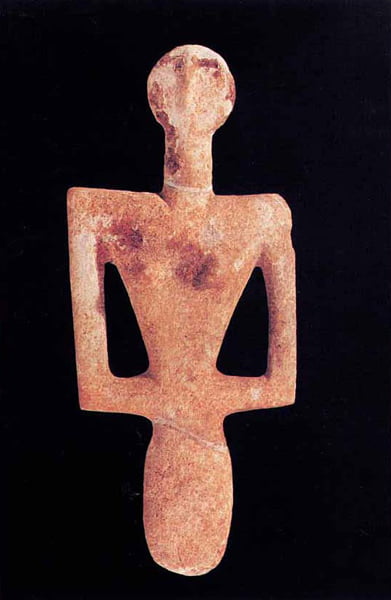
It is a typical cruciform Mother Goddess like that of Iron port, but also that of Turriga and of many others found in Sardinia which are generally attributed to the culture of Ozieri, but which inevitably refer to the civilization of the Goddess studied by Marija Gimbutas and to the Balkan peninsula, to the Cyclades, to a Mediterranean civilization (the one that will later be called dei Popoli del Mare?) which must have been extraordinary and wonderful, as well as having undeniable common traits that connect it with a past in which resilience still prevailed in the Mediterranean towards the invading peoples who finally brought their violent patriarchal civilization also to that Paradise (which became hell, stealing its definition from Sergio Frau).
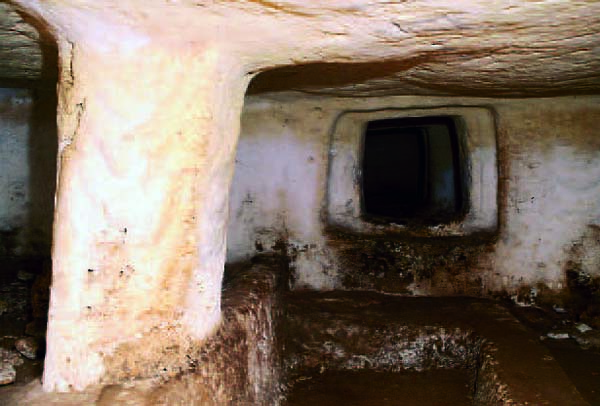
I think that many archaeological, linguistic, cultural and genetic clues and proofs should be better studied and without prejudice and biased positions.
Of course, it is also necessary to deal with the tendency for the Italian state to leave archaeological monuments in degradation and abandonment: Monte d'Accoddi, for example, is located in the middle of privately owned land, without an effective conservation policy, much less a tourism promotion. Tourists in Sardinia generally go for the sea, not for the archaeological monuments, but this depends a lot precisely on politics, which still prefers to characterize Sardinia, despite its archaeological and cultural heritage which is generally among the largest in the world, with stereotypes that they belong to a “colonial” past. Even these are really interesting to study, because they probably give us back the measure of how the civilization of ancient Sardinia was the object of a real damnatio memoriae on the part of the victors, the peoples of the patriarchy (unfortunately).
Roberto Marras
NB: by the same author Remote Links (legends and fairy tales about fairies, witches, janas and janares in Europe).
Footnotes
[1] The measurements reported on the relevant Wikipedia entry are slightly different.
[2] John Semerano The origins of European culture – I – Florence 1984 – p. 591.
[3] Above all, a prominent figure of Italian and Etruscan archeology in particular such as Massimo Pallottino, and "Sardinian" archaeologists in general, firmly doubted the Eastern and Mesopotamian syllogism in this case, given the fact that certain archaeological evidence does not exist .
[4] Hercules Contu – The prehistoric altar of Monte d'Accoddi - Sassari 2000 - p. 11-16 and in particular p. 13.
[5] Giovanni Lilliu – Art and religion of Prenuragic Sardinia - Sassari 1999.

